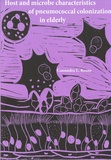Host and Microbe Characteristics of Pneumococcal Colonization in Elderly

Krone, Cassandra
- Promoter:
- Prof.dr. E.A.M. (Lieke) Sanders
- Co-promoter:
- Dr. D. (Debby) Bogaerts & dr. K.P. (Krzysztof) Trzcinski
- Research group:
- Sanders
- Date:
- October 29, 2013
- Time:
- 12:45 h
Summary
The focus of this thesis was to investigate various aspects of pneumococcal – host –commensal interactions in the respiratory tract of the elderly. Furthermore, we aimed to address the paucity of information regarding the underlying mechanisms of disease in this high risk group. Since Streptococcus pneumoniae is a frequent asymptomatic colonizer of the human upper respiratory tract, which is a prerequisite to disease, we approached this common medical problem through studies of colonization of the URT. We developed an elderly mouse model of pneumococcal colonization for studies on the effect of immunosenesence on innate mucosal immunity and mucosal homeostasis, and also for studies on the microbiota of the upper respiratory tract. We also performed a cross-sectional observational study in the elderly human population to study our hypotheses that 1. pneumococcal colonization rates in elderly are higher than assumed, and 2. the low sensitivity of carriage detection by conventional culture can be addressed by testing saliva samples from elderly adults with molecular methods. Last we tested and optimized a novel method of saliva collection and storage for surveillance, dried saliva spots. The major conclusions of this thesis are that ageing and immunosenescence seem to contribute significantly to an increased and prolonged colonization of the upper respiratory tract in elderly mouse models. Furthermore, in line with these findings, carriage in the elderly population is largely underestimated by the currently applied conventional culture methods of oro- and nasopharyngeal swabs, and is similar to the period prevalence of 40-65% already reported in historical data from early 20th century. This indicates that the pneumococcus is still largely a commensal even in elderly humans. With high rates of pneumococcal carriage in the oral cavity in the elderly, research should focus on reasons why the elderly as a group are highly susceptible to developing pneumococcal pneumonia and what makes an individual at high risk of developing consecutive disease. Microbiota studies of the upper respiratory tract, for example, may reveal important factors for microbial dysbiosis in the elderly, which may be relevant for development of new alternative preventive and therapeutic tools in the future. Better understanding of the process of immunosenescence at the upper respiratory tract and reasons behind disease development is essential for contributing to healthy ageing of a rapidly growing elderly population worldwide